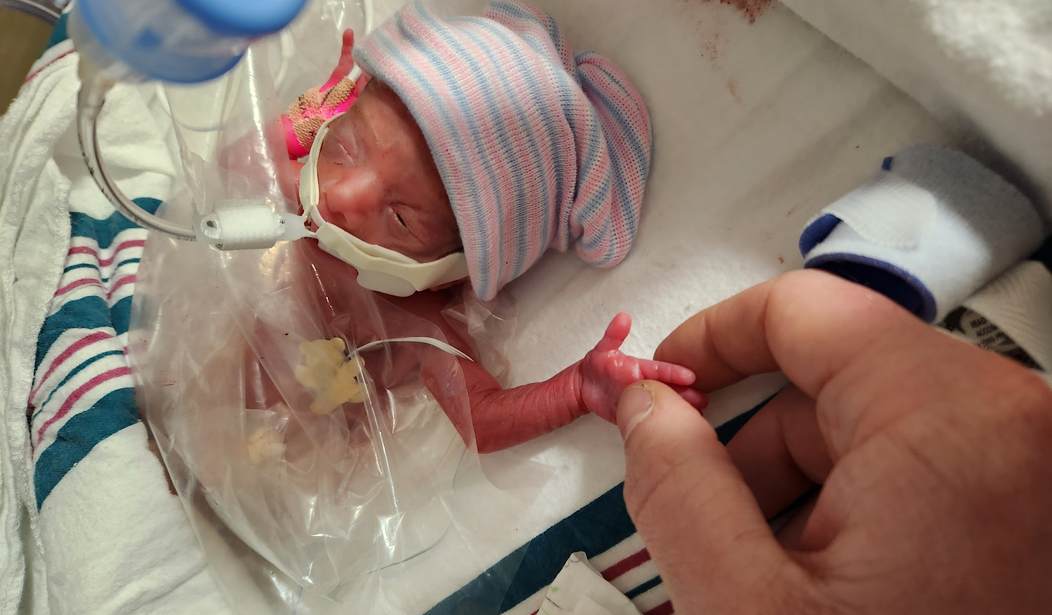Voters in Ohio will go to the polls Tuesday to decide the fate of thousands of unborn children whose mothers or fathers would like to kill them.
Yes, that’s harsh language, but that’s the reality of abortion, regardless of efforts to sanitize it as “reproductive health care,” which is how proponents of a referendum that would amend the Ohio Constitution are trying to advance the cult of death in the former swing state that has voted reliably Republican in recent years.
Right now, abortion is illegal in Ohio after 22 weeks of gestation. If Ohio Issue 1 is approved by a majority of voters, state legislators will be prohibited from regulating abortion before “fetal viability,” which is generally considered around 24 weeks of gestation but is not specified by the amendment and is left to the determination of the “pregnant patient’s” (the term “woman” doesn’t appear in the text of the amendment) doctor on a “case-by-by basis.”
I’ve always been pro-life, and although I remember being deeply disturbed by several widely publicized reports in the last dozen or so years about the atrocities of individuals and organizations that advocate for and practice abortion—such as the horrific crimes committed by Philadelphia abortionist Kermit Gosnell, the allegations that Planned Parenthood traffics in fetal body parts, and the discovery of murdered babies recovered from a Washington, D.C. abortion clinic—a recent experience personalized the issue for me in a way no news story ever could.
On September 27, my wife gave birth to our daughter (who I’ll call Rosie) more than 13 weeks before she was due when it was determined complications with the pregnancy were hindering her from growing like she should. At less than 27 weeks of gestation, Rosie was born weighing just 1 lb. 6 ozs., far below the 1st percentile for an unborn child of that age. A team of doctors and nurses immediately whisked her away and began giving her assistance breathing using a balloon-type device to pump oxygen into her tiny lungs.
After Rosie was stable, I got the chance to hold her hand, and as I did, I marveled at the intricacies of her features—perfectly formed fingers, toes, nose, and eyes—and her ability to move her tiny arms and legs. She was pretty active in the womb, and she continued to move around quite a bit after she was born.
David’s famous words from Psalm 139 came to mind.
13 For you created my inmost being;
you knit me together in my mother’s womb.
14 I praise you because I am fearfully and wonderfully made;
your works are wonderful,
I know that full well.
15 My frame was not hidden from you
when I was made in the secret place,
when I was woven together in the depths of the earth.
16 Your eyes saw my unformed body;
all the days ordained for me were written in your book
before one of them came to be.
In the last few weeks, I’ve watched Rosie open her eyes, get bigger, and progress from breathing with a ventilator to using a CPAP. She has a lot of growing to do before she can come home, but thanks to the wonders of modern medicine, the skill and dedication of countless doctors and nurses, and God’s infinite goodness, Rosie has a bright future ahead of her.
Rosie is truly a miracle, and as I’ve considered that undeniable truth, it repulses me to think that many people believe unborn children don’t deserve to live if their existence is an inconvenience to their mothers or fathers.
Despite claims to the contrary, gestational age isn’t a consideration for most abortion advocates, meaning an unborn child who looks a lot like my daughter did when she was born can be chopped up and discarded without a second thought.
Although proponents of Ohio Issue 1 argue the referendum’s stipulation that abortion can be prohibited after fetal viability is a reasonable policy that gives equal weight to common moral sensibilities and the right to bodily autonomy, that supposed restriction is nothing more than a facade. Letting abortion providers determine the meaning of “viability” is asinine, and even that flimsy standard is subject to exceptions in which “it is necessary to protect the pregnant patient’s life or health,” which can include manufactured concerns about depression or anxiety.
Interestingly, the American College of Obstetricians and Gynecologists “strongly discourages the inclusion of viability in legislation or regulation.”
According to opponents of the referendum, its approval would likely invalidate laws currently on the books requiring abortion facilities to get parental consent before performing an abortion on a minor, provide women seeking an abortion information about the development of their unborn child, and wait 24 hours after an initial consultation with a client to perform an abortion. They also contend it would enable child predators to perform gender transition surgeries on minors without obtaining their parents’ consent.
In addition, the referendum will directly impact the fate of a 2019 state law prohibiting abortion after the detection of a heartbeat.
Prior to the overturning of Roe v. Wade last year, a federal judge ruled the heartbeat law violated the U.S. Constitution because it imposed an “undue burden” (a standard created by the 1992 U.S. Supreme Court ruling in Planned Parenthood of Southeastern Pennsylvania v. Casey) on a woman seeking an abortion, but that ruling was rendered moot when the issue of abortion was returned to the states, allowing Ohio officials to implement the law. Abortion advocates then sued to block the law on the grounds it violated the state constitution, which was amended after the passage of Obamacare to guarantee an individual’s right to acquire health care. A lower court agreed with this argument, and state officials appealed the ruling. The case is currently pending in the Ohio Supreme Court.
Since the U.S. Supreme Court overturned Roe v. Wade last year, pro-choice advocates have found success pushing abortion access through popular referendums in red and blue states alike. Last year, voters in California, Michigan, and Vermont enshrined the right to abortion in their state constitutions, and voters in Kansas and Kentucky rejected referendums that would have clarified their state constitutions do not contain an implied right to abortion. Next year, referendums similar to Ohio Issue 1 could appear on the ballot in several states, including Arizona, Florida, and South Dakota.









Join the conversation as a VIP Member